Labor and Employment Law: Employee vs. Independent Contractor Analysis
VerifiedAdded on 2021/05/31
|9
|2279
|126
Report
AI Summary
This report delves into the intricacies of labor and employment law, focusing on the critical distinction between employees and independent contractors under Australian law. It examines the legal definitions, including those outlined in the Fair Work Act 2009, and explores the factors used to determine employee status, such as control, integration, and the multi-factor test. The report also addresses the concept of vicarious liability, discussing the circumstances under which employers can be held liable for the actions of their employees, particularly in cases of negligence. Furthermore, it analyzes the application of employment contracts, modern awards, and dispute settlement processes within the context of on-hire businesses and employee entitlements. The report uses case studies to illustrate the practical implications of these legal principles, providing a comprehensive overview of key issues in labor and employment law.
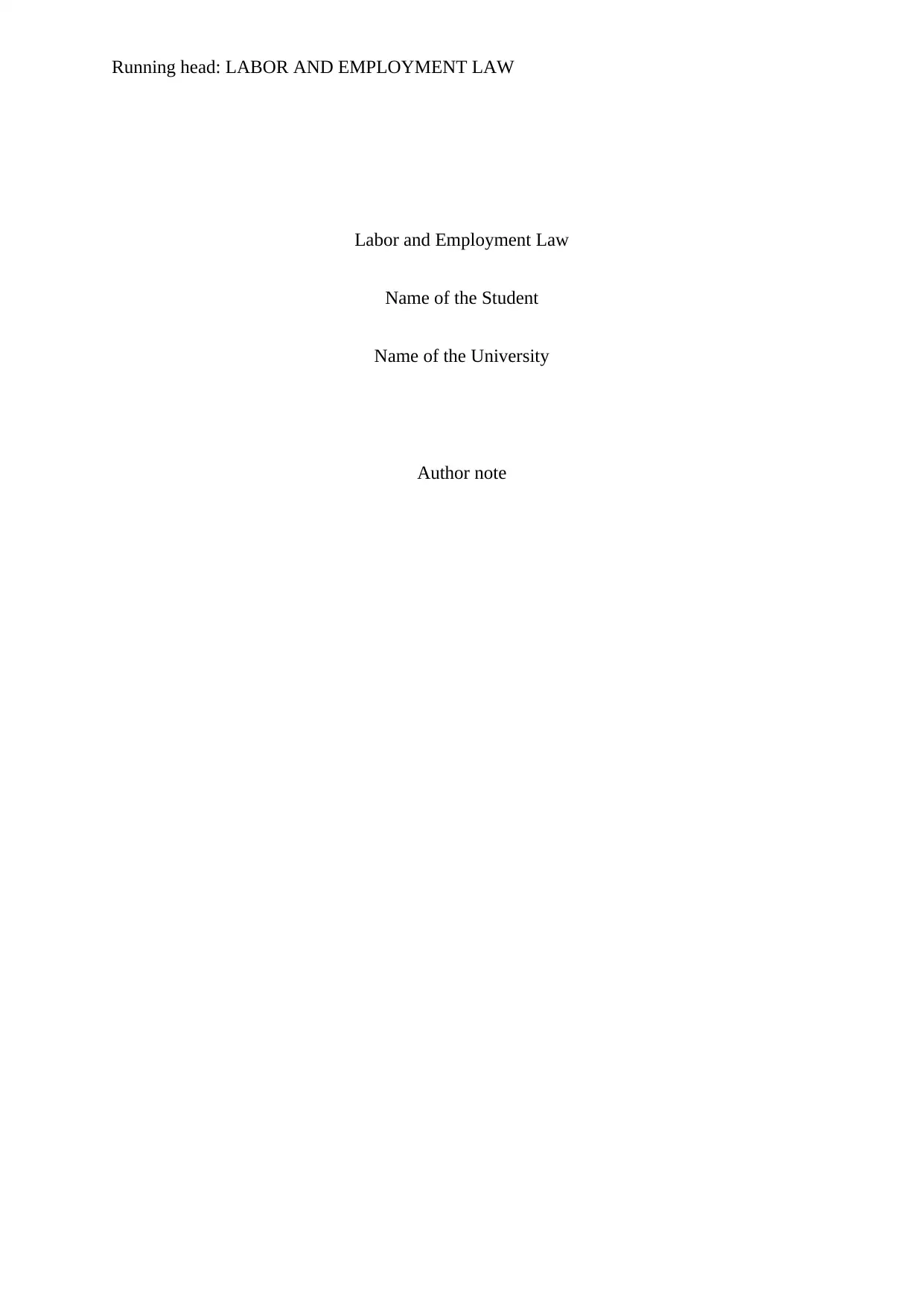
Running head: LABOR AND EMPLOYMENT LAW
Labor and Employment Law
Name of the Student
Name of the University
Author note
Labor and Employment Law
Name of the Student
Name of the University
Author note
Paraphrase This Document
Need a fresh take? Get an instant paraphrase of this document with our AI Paraphraser
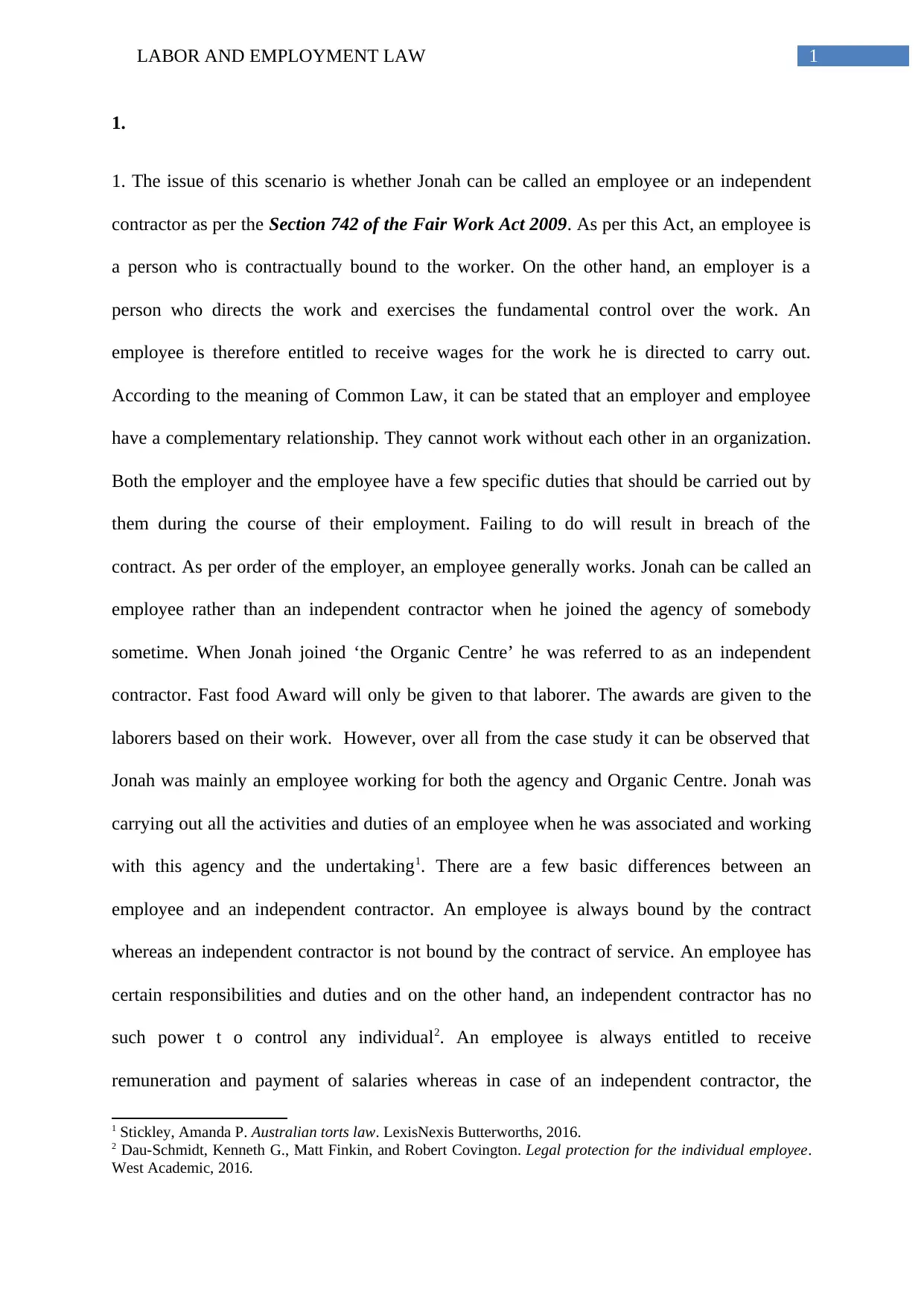
1LABOR AND EMPLOYMENT LAW
1.
1. The issue of this scenario is whether Jonah can be called an employee or an independent
contractor as per the Section 742 of the Fair Work Act 2009. As per this Act, an employee is
a person who is contractually bound to the worker. On the other hand, an employer is a
person who directs the work and exercises the fundamental control over the work. An
employee is therefore entitled to receive wages for the work he is directed to carry out.
According to the meaning of Common Law, it can be stated that an employer and employee
have a complementary relationship. They cannot work without each other in an organization.
Both the employer and the employee have a few specific duties that should be carried out by
them during the course of their employment. Failing to do will result in breach of the
contract. As per order of the employer, an employee generally works. Jonah can be called an
employee rather than an independent contractor when he joined the agency of somebody
sometime. When Jonah joined ‘the Organic Centre’ he was referred to as an independent
contractor. Fast food Award will only be given to that laborer. The awards are given to the
laborers based on their work. However, over all from the case study it can be observed that
Jonah was mainly an employee working for both the agency and Organic Centre. Jonah was
carrying out all the activities and duties of an employee when he was associated and working
with this agency and the undertaking1. There are a few basic differences between an
employee and an independent contractor. An employee is always bound by the contract
whereas an independent contractor is not bound by the contract of service. An employee has
certain responsibilities and duties and on the other hand, an independent contractor has no
such power t o control any individual2. An employee is always entitled to receive
remuneration and payment of salaries whereas in case of an independent contractor, the
1 Stickley, Amanda P. Australian torts law. LexisNexis Butterworths, 2016.
2 Dau-Schmidt, Kenneth G., Matt Finkin, and Robert Covington. Legal protection for the individual employee.
West Academic, 2016.
1.
1. The issue of this scenario is whether Jonah can be called an employee or an independent
contractor as per the Section 742 of the Fair Work Act 2009. As per this Act, an employee is
a person who is contractually bound to the worker. On the other hand, an employer is a
person who directs the work and exercises the fundamental control over the work. An
employee is therefore entitled to receive wages for the work he is directed to carry out.
According to the meaning of Common Law, it can be stated that an employer and employee
have a complementary relationship. They cannot work without each other in an organization.
Both the employer and the employee have a few specific duties that should be carried out by
them during the course of their employment. Failing to do will result in breach of the
contract. As per order of the employer, an employee generally works. Jonah can be called an
employee rather than an independent contractor when he joined the agency of somebody
sometime. When Jonah joined ‘the Organic Centre’ he was referred to as an independent
contractor. Fast food Award will only be given to that laborer. The awards are given to the
laborers based on their work. However, over all from the case study it can be observed that
Jonah was mainly an employee working for both the agency and Organic Centre. Jonah was
carrying out all the activities and duties of an employee when he was associated and working
with this agency and the undertaking1. There are a few basic differences between an
employee and an independent contractor. An employee is always bound by the contract
whereas an independent contractor is not bound by the contract of service. An employee has
certain responsibilities and duties and on the other hand, an independent contractor has no
such power t o control any individual2. An employee is always entitled to receive
remuneration and payment of salaries whereas in case of an independent contractor, the
1 Stickley, Amanda P. Australian torts law. LexisNexis Butterworths, 2016.
2 Dau-Schmidt, Kenneth G., Matt Finkin, and Robert Covington. Legal protection for the individual employee.
West Academic, 2016.
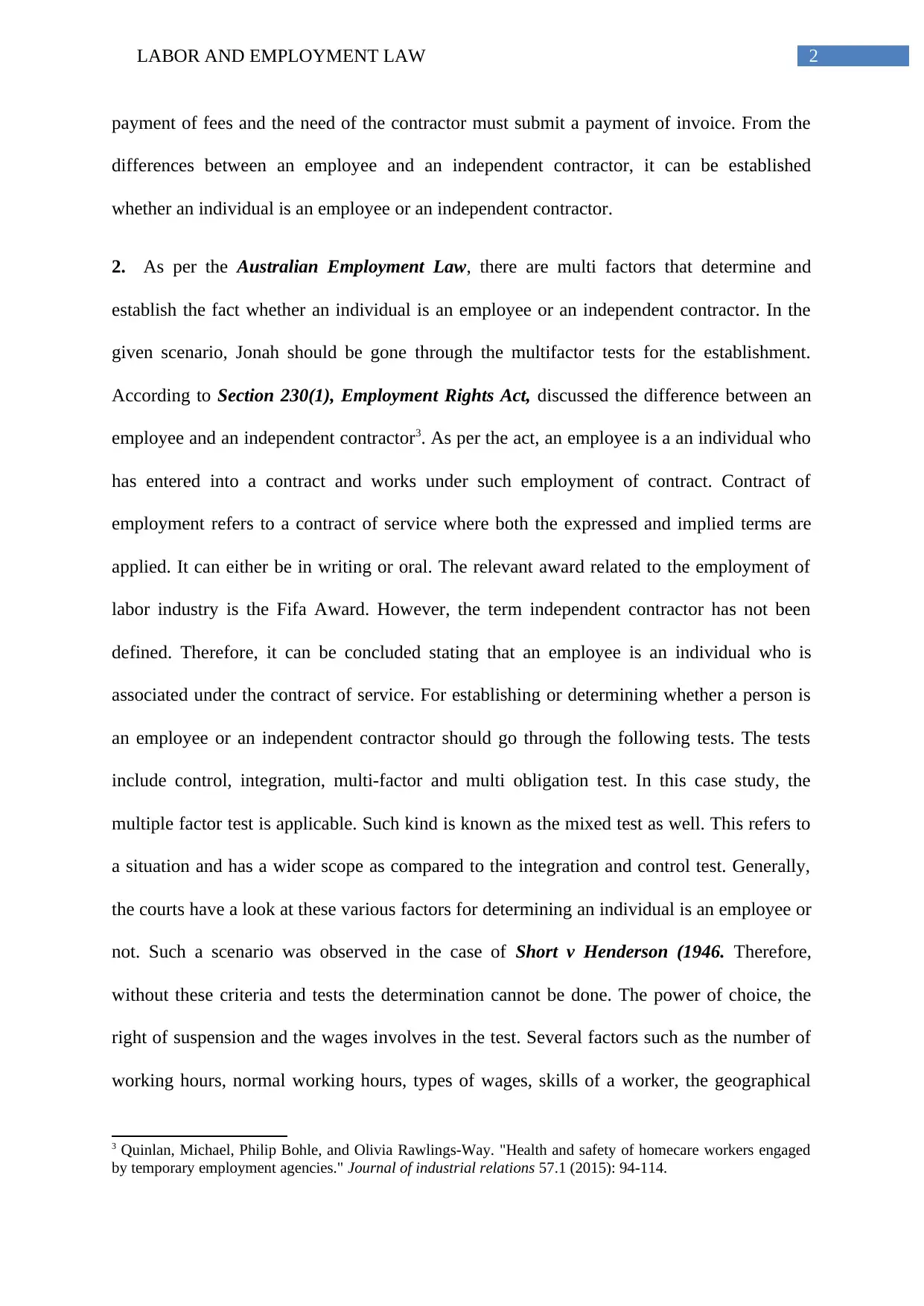
2LABOR AND EMPLOYMENT LAW
payment of fees and the need of the contractor must submit a payment of invoice. From the
differences between an employee and an independent contractor, it can be established
whether an individual is an employee or an independent contractor.
2. As per the Australian Employment Law, there are multi factors that determine and
establish the fact whether an individual is an employee or an independent contractor. In the
given scenario, Jonah should be gone through the multifactor tests for the establishment.
According to Section 230(1), Employment Rights Act, discussed the difference between an
employee and an independent contractor3. As per the act, an employee is a an individual who
has entered into a contract and works under such employment of contract. Contract of
employment refers to a contract of service where both the expressed and implied terms are
applied. It can either be in writing or oral. The relevant award related to the employment of
labor industry is the Fifa Award. However, the term independent contractor has not been
defined. Therefore, it can be concluded stating that an employee is an individual who is
associated under the contract of service. For establishing or determining whether a person is
an employee or an independent contractor should go through the following tests. The tests
include control, integration, multi-factor and multi obligation test. In this case study, the
multiple factor test is applicable. Such kind is known as the mixed test as well. This refers to
a situation and has a wider scope as compared to the integration and control test. Generally,
the courts have a look at these various factors for determining an individual is an employee or
not. Such a scenario was observed in the case of Short v Henderson (1946. Therefore,
without these criteria and tests the determination cannot be done. The power of choice, the
right of suspension and the wages involves in the test. Several factors such as the number of
working hours, normal working hours, types of wages, skills of a worker, the geographical
3 Quinlan, Michael, Philip Bohle, and Olivia Rawlings-Way. "Health and safety of homecare workers engaged
by temporary employment agencies." Journal of industrial relations 57.1 (2015): 94-114.
payment of fees and the need of the contractor must submit a payment of invoice. From the
differences between an employee and an independent contractor, it can be established
whether an individual is an employee or an independent contractor.
2. As per the Australian Employment Law, there are multi factors that determine and
establish the fact whether an individual is an employee or an independent contractor. In the
given scenario, Jonah should be gone through the multifactor tests for the establishment.
According to Section 230(1), Employment Rights Act, discussed the difference between an
employee and an independent contractor3. As per the act, an employee is a an individual who
has entered into a contract and works under such employment of contract. Contract of
employment refers to a contract of service where both the expressed and implied terms are
applied. It can either be in writing or oral. The relevant award related to the employment of
labor industry is the Fifa Award. However, the term independent contractor has not been
defined. Therefore, it can be concluded stating that an employee is an individual who is
associated under the contract of service. For establishing or determining whether a person is
an employee or an independent contractor should go through the following tests. The tests
include control, integration, multi-factor and multi obligation test. In this case study, the
multiple factor test is applicable. Such kind is known as the mixed test as well. This refers to
a situation and has a wider scope as compared to the integration and control test. Generally,
the courts have a look at these various factors for determining an individual is an employee or
not. Such a scenario was observed in the case of Short v Henderson (1946. Therefore,
without these criteria and tests the determination cannot be done. The power of choice, the
right of suspension and the wages involves in the test. Several factors such as the number of
working hours, normal working hours, types of wages, skills of a worker, the geographical
3 Quinlan, Michael, Philip Bohle, and Olivia Rawlings-Way. "Health and safety of homecare workers engaged
by temporary employment agencies." Journal of industrial relations 57.1 (2015): 94-114.
⊘ This is a preview!⊘
Do you want full access?
Subscribe today to unlock all pages.

Trusted by 1+ million students worldwide
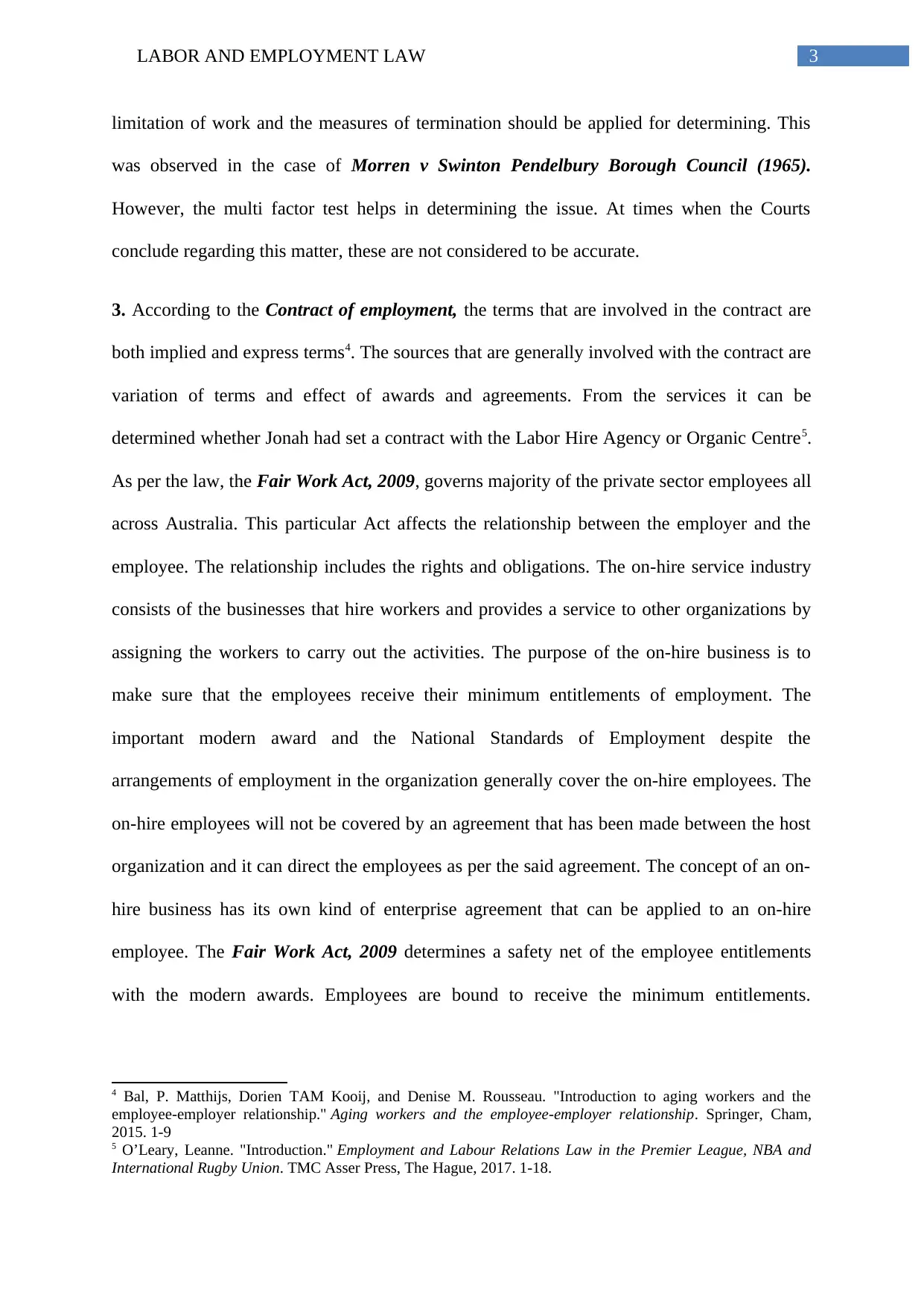
3LABOR AND EMPLOYMENT LAW
limitation of work and the measures of termination should be applied for determining. This
was observed in the case of Morren v Swinton Pendelbury Borough Council (1965).
However, the multi factor test helps in determining the issue. At times when the Courts
conclude regarding this matter, these are not considered to be accurate.
3. According to the Contract of employment, the terms that are involved in the contract are
both implied and express terms4. The sources that are generally involved with the contract are
variation of terms and effect of awards and agreements. From the services it can be
determined whether Jonah had set a contract with the Labor Hire Agency or Organic Centre5.
As per the law, the Fair Work Act, 2009, governs majority of the private sector employees all
across Australia. This particular Act affects the relationship between the employer and the
employee. The relationship includes the rights and obligations. The on-hire service industry
consists of the businesses that hire workers and provides a service to other organizations by
assigning the workers to carry out the activities. The purpose of the on-hire business is to
make sure that the employees receive their minimum entitlements of employment. The
important modern award and the National Standards of Employment despite the
arrangements of employment in the organization generally cover the on-hire employees. The
on-hire employees will not be covered by an agreement that has been made between the host
organization and it can direct the employees as per the said agreement. The concept of an on-
hire business has its own kind of enterprise agreement that can be applied to an on-hire
employee. The Fair Work Act, 2009 determines a safety net of the employee entitlements
with the modern awards. Employees are bound to receive the minimum entitlements.
4 Bal, P. Matthijs, Dorien TAM Kooij, and Denise M. Rousseau. "Introduction to aging workers and the
employee-employer relationship." Aging workers and the employee-employer relationship. Springer, Cham,
2015. 1-9
5 O’Leary, Leanne. "Introduction." Employment and Labour Relations Law in the Premier League, NBA and
International Rugby Union. TMC Asser Press, The Hague, 2017. 1-18.
limitation of work and the measures of termination should be applied for determining. This
was observed in the case of Morren v Swinton Pendelbury Borough Council (1965).
However, the multi factor test helps in determining the issue. At times when the Courts
conclude regarding this matter, these are not considered to be accurate.
3. According to the Contract of employment, the terms that are involved in the contract are
both implied and express terms4. The sources that are generally involved with the contract are
variation of terms and effect of awards and agreements. From the services it can be
determined whether Jonah had set a contract with the Labor Hire Agency or Organic Centre5.
As per the law, the Fair Work Act, 2009, governs majority of the private sector employees all
across Australia. This particular Act affects the relationship between the employer and the
employee. The relationship includes the rights and obligations. The on-hire service industry
consists of the businesses that hire workers and provides a service to other organizations by
assigning the workers to carry out the activities. The purpose of the on-hire business is to
make sure that the employees receive their minimum entitlements of employment. The
important modern award and the National Standards of Employment despite the
arrangements of employment in the organization generally cover the on-hire employees. The
on-hire employees will not be covered by an agreement that has been made between the host
organization and it can direct the employees as per the said agreement. The concept of an on-
hire business has its own kind of enterprise agreement that can be applied to an on-hire
employee. The Fair Work Act, 2009 determines a safety net of the employee entitlements
with the modern awards. Employees are bound to receive the minimum entitlements.
4 Bal, P. Matthijs, Dorien TAM Kooij, and Denise M. Rousseau. "Introduction to aging workers and the
employee-employer relationship." Aging workers and the employee-employer relationship. Springer, Cham,
2015. 1-9
5 O’Leary, Leanne. "Introduction." Employment and Labour Relations Law in the Premier League, NBA and
International Rugby Union. TMC Asser Press, The Hague, 2017. 1-18.
Paraphrase This Document
Need a fresh take? Get an instant paraphrase of this document with our AI Paraphraser
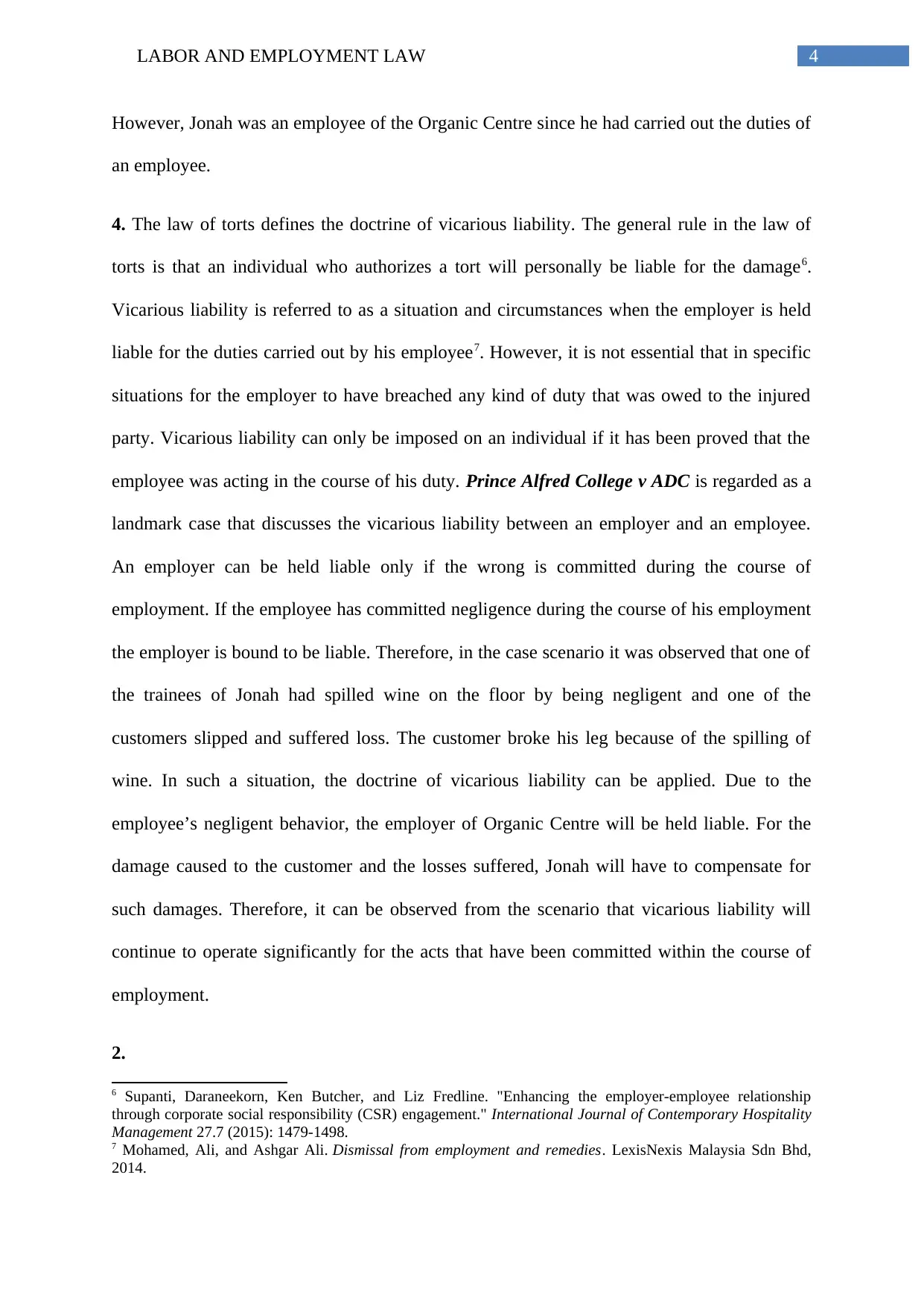
4LABOR AND EMPLOYMENT LAW
However, Jonah was an employee of the Organic Centre since he had carried out the duties of
an employee.
4. The law of torts defines the doctrine of vicarious liability. The general rule in the law of
torts is that an individual who authorizes a tort will personally be liable for the damage6.
Vicarious liability is referred to as a situation and circumstances when the employer is held
liable for the duties carried out by his employee7. However, it is not essential that in specific
situations for the employer to have breached any kind of duty that was owed to the injured
party. Vicarious liability can only be imposed on an individual if it has been proved that the
employee was acting in the course of his duty. Prince Alfred College v ADC is regarded as a
landmark case that discusses the vicarious liability between an employer and an employee.
An employer can be held liable only if the wrong is committed during the course of
employment. If the employee has committed negligence during the course of his employment
the employer is bound to be liable. Therefore, in the case scenario it was observed that one of
the trainees of Jonah had spilled wine on the floor by being negligent and one of the
customers slipped and suffered loss. The customer broke his leg because of the spilling of
wine. In such a situation, the doctrine of vicarious liability can be applied. Due to the
employee’s negligent behavior, the employer of Organic Centre will be held liable. For the
damage caused to the customer and the losses suffered, Jonah will have to compensate for
such damages. Therefore, it can be observed from the scenario that vicarious liability will
continue to operate significantly for the acts that have been committed within the course of
employment.
2.
6 Supanti, Daraneekorn, Ken Butcher, and Liz Fredline. "Enhancing the employer-employee relationship
through corporate social responsibility (CSR) engagement." International Journal of Contemporary Hospitality
Management 27.7 (2015): 1479-1498.
7 Mohamed, Ali, and Ashgar Ali. Dismissal from employment and remedies. LexisNexis Malaysia Sdn Bhd,
2014.
However, Jonah was an employee of the Organic Centre since he had carried out the duties of
an employee.
4. The law of torts defines the doctrine of vicarious liability. The general rule in the law of
torts is that an individual who authorizes a tort will personally be liable for the damage6.
Vicarious liability is referred to as a situation and circumstances when the employer is held
liable for the duties carried out by his employee7. However, it is not essential that in specific
situations for the employer to have breached any kind of duty that was owed to the injured
party. Vicarious liability can only be imposed on an individual if it has been proved that the
employee was acting in the course of his duty. Prince Alfred College v ADC is regarded as a
landmark case that discusses the vicarious liability between an employer and an employee.
An employer can be held liable only if the wrong is committed during the course of
employment. If the employee has committed negligence during the course of his employment
the employer is bound to be liable. Therefore, in the case scenario it was observed that one of
the trainees of Jonah had spilled wine on the floor by being negligent and one of the
customers slipped and suffered loss. The customer broke his leg because of the spilling of
wine. In such a situation, the doctrine of vicarious liability can be applied. Due to the
employee’s negligent behavior, the employer of Organic Centre will be held liable. For the
damage caused to the customer and the losses suffered, Jonah will have to compensate for
such damages. Therefore, it can be observed from the scenario that vicarious liability will
continue to operate significantly for the acts that have been committed within the course of
employment.
2.
6 Supanti, Daraneekorn, Ken Butcher, and Liz Fredline. "Enhancing the employer-employee relationship
through corporate social responsibility (CSR) engagement." International Journal of Contemporary Hospitality
Management 27.7 (2015): 1479-1498.
7 Mohamed, Ali, and Ashgar Ali. Dismissal from employment and remedies. LexisNexis Malaysia Sdn Bhd,
2014.
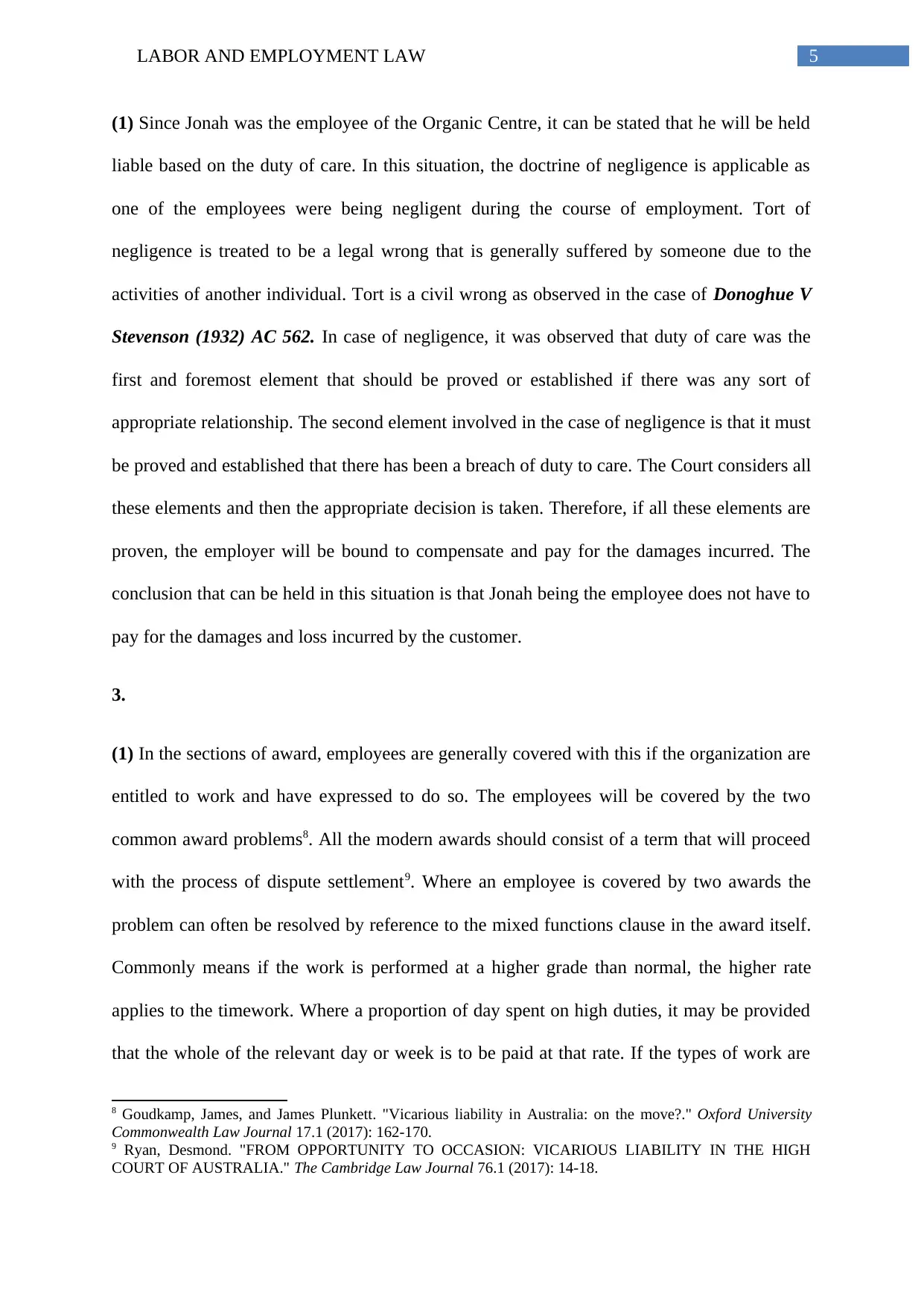
5LABOR AND EMPLOYMENT LAW
(1) Since Jonah was the employee of the Organic Centre, it can be stated that he will be held
liable based on the duty of care. In this situation, the doctrine of negligence is applicable as
one of the employees were being negligent during the course of employment. Tort of
negligence is treated to be a legal wrong that is generally suffered by someone due to the
activities of another individual. Tort is a civil wrong as observed in the case of Donoghue V
Stevenson (1932) AC 562. In case of negligence, it was observed that duty of care was the
first and foremost element that should be proved or established if there was any sort of
appropriate relationship. The second element involved in the case of negligence is that it must
be proved and established that there has been a breach of duty to care. The Court considers all
these elements and then the appropriate decision is taken. Therefore, if all these elements are
proven, the employer will be bound to compensate and pay for the damages incurred. The
conclusion that can be held in this situation is that Jonah being the employee does not have to
pay for the damages and loss incurred by the customer.
3.
(1) In the sections of award, employees are generally covered with this if the organization are
entitled to work and have expressed to do so. The employees will be covered by the two
common award problems8. All the modern awards should consist of a term that will proceed
with the process of dispute settlement9. Where an employee is covered by two awards the
problem can often be resolved by reference to the mixed functions clause in the award itself.
Commonly means if the work is performed at a higher grade than normal, the higher rate
applies to the timework. Where a proportion of day spent on high duties, it may be provided
that the whole of the relevant day or week is to be paid at that rate. If the types of work are
8 Goudkamp, James, and James Plunkett. "Vicarious liability in Australia: on the move?." Oxford University
Commonwealth Law Journal 17.1 (2017): 162-170.
9 Ryan, Desmond. "FROM OPPORTUNITY TO OCCASION: VICARIOUS LIABILITY IN THE HIGH
COURT OF AUSTRALIA." The Cambridge Law Journal 76.1 (2017): 14-18.
(1) Since Jonah was the employee of the Organic Centre, it can be stated that he will be held
liable based on the duty of care. In this situation, the doctrine of negligence is applicable as
one of the employees were being negligent during the course of employment. Tort of
negligence is treated to be a legal wrong that is generally suffered by someone due to the
activities of another individual. Tort is a civil wrong as observed in the case of Donoghue V
Stevenson (1932) AC 562. In case of negligence, it was observed that duty of care was the
first and foremost element that should be proved or established if there was any sort of
appropriate relationship. The second element involved in the case of negligence is that it must
be proved and established that there has been a breach of duty to care. The Court considers all
these elements and then the appropriate decision is taken. Therefore, if all these elements are
proven, the employer will be bound to compensate and pay for the damages incurred. The
conclusion that can be held in this situation is that Jonah being the employee does not have to
pay for the damages and loss incurred by the customer.
3.
(1) In the sections of award, employees are generally covered with this if the organization are
entitled to work and have expressed to do so. The employees will be covered by the two
common award problems8. All the modern awards should consist of a term that will proceed
with the process of dispute settlement9. Where an employee is covered by two awards the
problem can often be resolved by reference to the mixed functions clause in the award itself.
Commonly means if the work is performed at a higher grade than normal, the higher rate
applies to the timework. Where a proportion of day spent on high duties, it may be provided
that the whole of the relevant day or week is to be paid at that rate. If the types of work are
8 Goudkamp, James, and James Plunkett. "Vicarious liability in Australia: on the move?." Oxford University
Commonwealth Law Journal 17.1 (2017): 162-170.
9 Ryan, Desmond. "FROM OPPORTUNITY TO OCCASION: VICARIOUS LIABILITY IN THE HIGH
COURT OF AUSTRALIA." The Cambridge Law Journal 76.1 (2017): 14-18.
⊘ This is a preview!⊘
Do you want full access?
Subscribe today to unlock all pages.

Trusted by 1+ million students worldwide
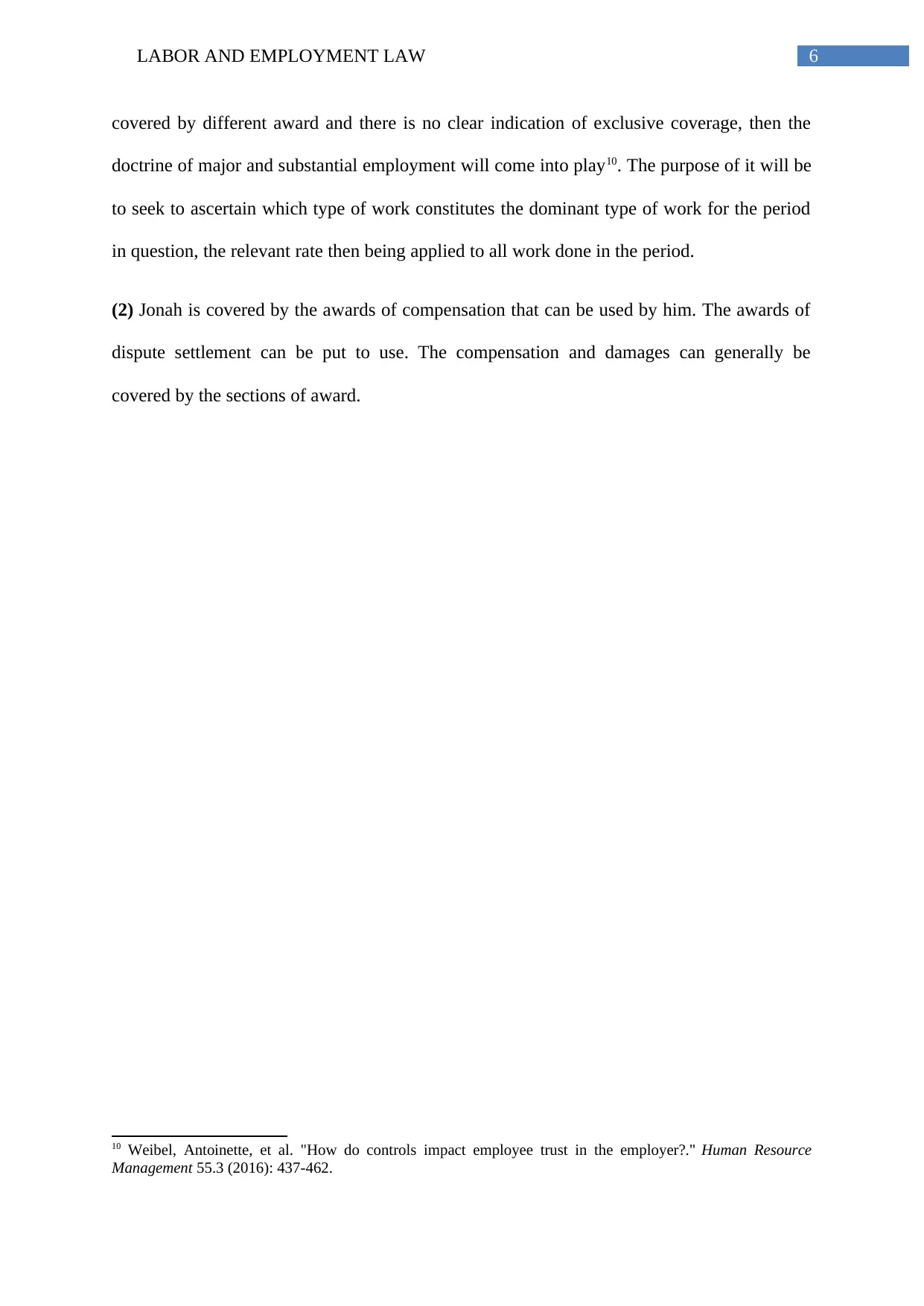
6LABOR AND EMPLOYMENT LAW
covered by different award and there is no clear indication of exclusive coverage, then the
doctrine of major and substantial employment will come into play10. The purpose of it will be
to seek to ascertain which type of work constitutes the dominant type of work for the period
in question, the relevant rate then being applied to all work done in the period.
(2) Jonah is covered by the awards of compensation that can be used by him. The awards of
dispute settlement can be put to use. The compensation and damages can generally be
covered by the sections of award.
10 Weibel, Antoinette, et al. "How do controls impact employee trust in the employer?." Human Resource
Management 55.3 (2016): 437-462.
covered by different award and there is no clear indication of exclusive coverage, then the
doctrine of major and substantial employment will come into play10. The purpose of it will be
to seek to ascertain which type of work constitutes the dominant type of work for the period
in question, the relevant rate then being applied to all work done in the period.
(2) Jonah is covered by the awards of compensation that can be used by him. The awards of
dispute settlement can be put to use. The compensation and damages can generally be
covered by the sections of award.
10 Weibel, Antoinette, et al. "How do controls impact employee trust in the employer?." Human Resource
Management 55.3 (2016): 437-462.
Paraphrase This Document
Need a fresh take? Get an instant paraphrase of this document with our AI Paraphraser
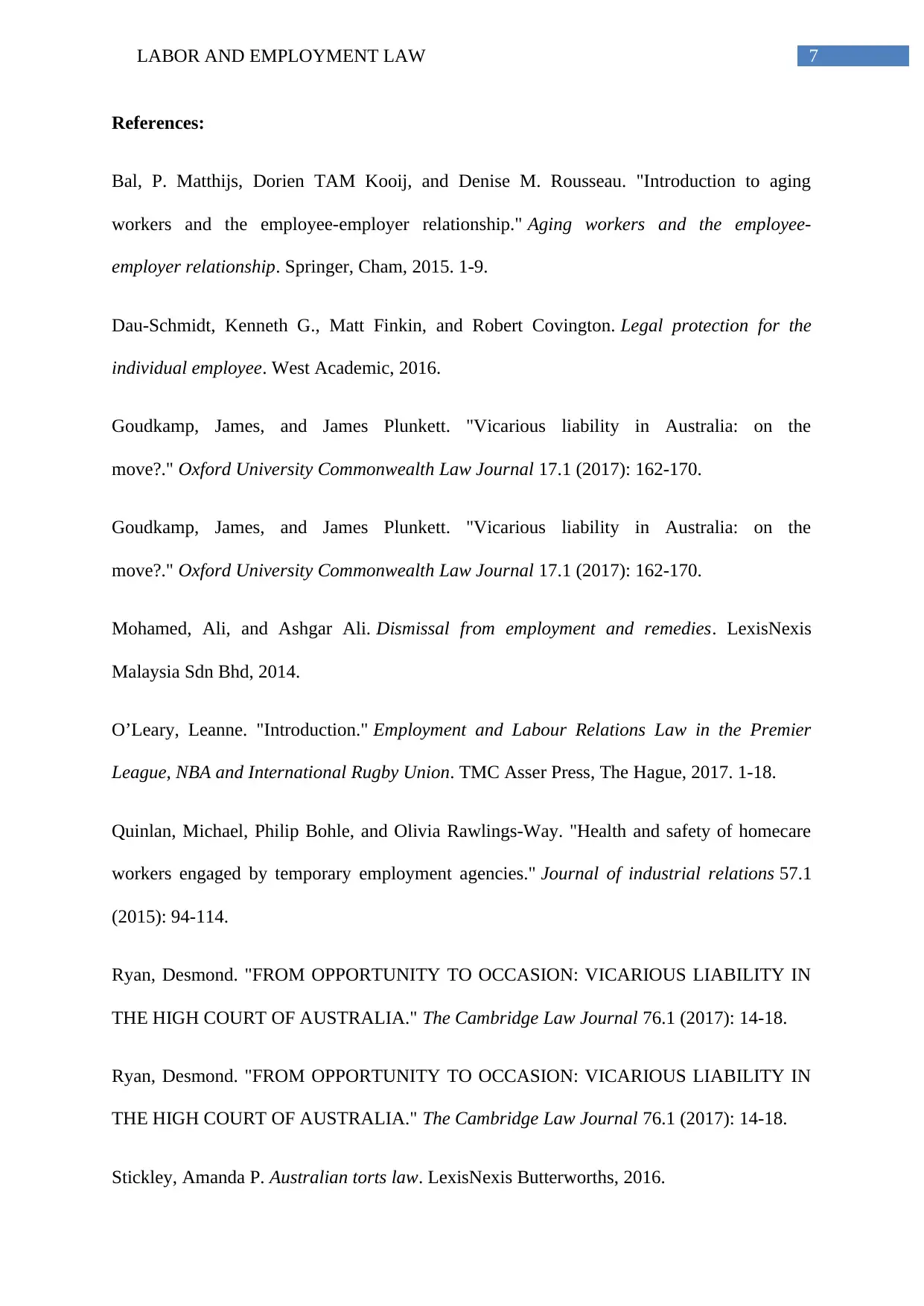
7LABOR AND EMPLOYMENT LAW
References:
Bal, P. Matthijs, Dorien TAM Kooij, and Denise M. Rousseau. "Introduction to aging
workers and the employee-employer relationship." Aging workers and the employee-
employer relationship. Springer, Cham, 2015. 1-9.
Dau-Schmidt, Kenneth G., Matt Finkin, and Robert Covington. Legal protection for the
individual employee. West Academic, 2016.
Goudkamp, James, and James Plunkett. "Vicarious liability in Australia: on the
move?." Oxford University Commonwealth Law Journal 17.1 (2017): 162-170.
Goudkamp, James, and James Plunkett. "Vicarious liability in Australia: on the
move?." Oxford University Commonwealth Law Journal 17.1 (2017): 162-170.
Mohamed, Ali, and Ashgar Ali. Dismissal from employment and remedies. LexisNexis
Malaysia Sdn Bhd, 2014.
O’Leary, Leanne. "Introduction." Employment and Labour Relations Law in the Premier
League, NBA and International Rugby Union. TMC Asser Press, The Hague, 2017. 1-18.
Quinlan, Michael, Philip Bohle, and Olivia Rawlings-Way. "Health and safety of homecare
workers engaged by temporary employment agencies." Journal of industrial relations 57.1
(2015): 94-114.
Ryan, Desmond. "FROM OPPORTUNITY TO OCCASION: VICARIOUS LIABILITY IN
THE HIGH COURT OF AUSTRALIA." The Cambridge Law Journal 76.1 (2017): 14-18.
Ryan, Desmond. "FROM OPPORTUNITY TO OCCASION: VICARIOUS LIABILITY IN
THE HIGH COURT OF AUSTRALIA." The Cambridge Law Journal 76.1 (2017): 14-18.
Stickley, Amanda P. Australian torts law. LexisNexis Butterworths, 2016.
References:
Bal, P. Matthijs, Dorien TAM Kooij, and Denise M. Rousseau. "Introduction to aging
workers and the employee-employer relationship." Aging workers and the employee-
employer relationship. Springer, Cham, 2015. 1-9.
Dau-Schmidt, Kenneth G., Matt Finkin, and Robert Covington. Legal protection for the
individual employee. West Academic, 2016.
Goudkamp, James, and James Plunkett. "Vicarious liability in Australia: on the
move?." Oxford University Commonwealth Law Journal 17.1 (2017): 162-170.
Goudkamp, James, and James Plunkett. "Vicarious liability in Australia: on the
move?." Oxford University Commonwealth Law Journal 17.1 (2017): 162-170.
Mohamed, Ali, and Ashgar Ali. Dismissal from employment and remedies. LexisNexis
Malaysia Sdn Bhd, 2014.
O’Leary, Leanne. "Introduction." Employment and Labour Relations Law in the Premier
League, NBA and International Rugby Union. TMC Asser Press, The Hague, 2017. 1-18.
Quinlan, Michael, Philip Bohle, and Olivia Rawlings-Way. "Health and safety of homecare
workers engaged by temporary employment agencies." Journal of industrial relations 57.1
(2015): 94-114.
Ryan, Desmond. "FROM OPPORTUNITY TO OCCASION: VICARIOUS LIABILITY IN
THE HIGH COURT OF AUSTRALIA." The Cambridge Law Journal 76.1 (2017): 14-18.
Ryan, Desmond. "FROM OPPORTUNITY TO OCCASION: VICARIOUS LIABILITY IN
THE HIGH COURT OF AUSTRALIA." The Cambridge Law Journal 76.1 (2017): 14-18.
Stickley, Amanda P. Australian torts law. LexisNexis Butterworths, 2016.
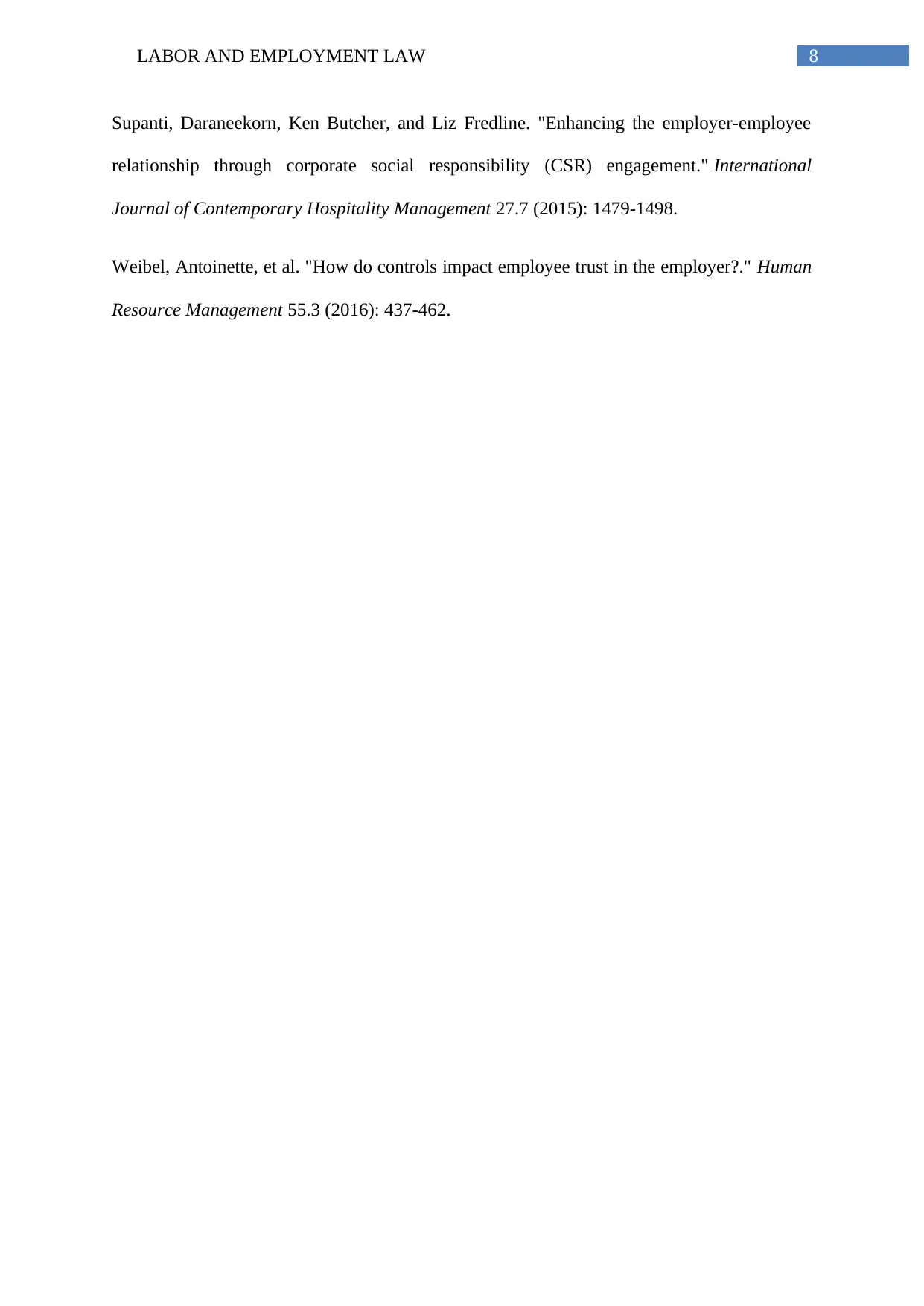
8LABOR AND EMPLOYMENT LAW
Supanti, Daraneekorn, Ken Butcher, and Liz Fredline. "Enhancing the employer-employee
relationship through corporate social responsibility (CSR) engagement." International
Journal of Contemporary Hospitality Management 27.7 (2015): 1479-1498.
Weibel, Antoinette, et al. "How do controls impact employee trust in the employer?." Human
Resource Management 55.3 (2016): 437-462.
Supanti, Daraneekorn, Ken Butcher, and Liz Fredline. "Enhancing the employer-employee
relationship through corporate social responsibility (CSR) engagement." International
Journal of Contemporary Hospitality Management 27.7 (2015): 1479-1498.
Weibel, Antoinette, et al. "How do controls impact employee trust in the employer?." Human
Resource Management 55.3 (2016): 437-462.
⊘ This is a preview!⊘
Do you want full access?
Subscribe today to unlock all pages.

Trusted by 1+ million students worldwide
1 out of 9
Related Documents
Your All-in-One AI-Powered Toolkit for Academic Success.
+13062052269
info@desklib.com
Available 24*7 on WhatsApp / Email
![[object Object]](/_next/static/media/star-bottom.7253800d.svg)
Unlock your academic potential
Copyright © 2020–2025 A2Z Services. All Rights Reserved. Developed and managed by ZUCOL.





